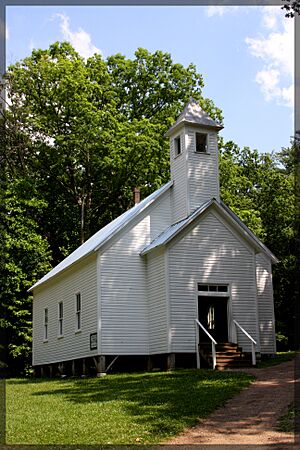List of ghost towns in Tennessee facts for kids
A ghost town is a place where people used to live and work, but now it's mostly empty. This often happens when the main reason people were there, like a mine or a factory, closes down. Sometimes, towns become ghost towns because of natural disasters or big projects like building a dam. Tennessee has several interesting ghost towns, each with its own story.
Contents
Ghost Towns in Tennessee
Ghost towns in Tennessee tell tales of the past. They show how communities grew around industries like mining or logging, and how they faded away when those industries changed. Some towns were even flooded to make way for new lakes!
"Old" Butler
"Old" Butler was a small town in Johnson County, Tennessee. It was a lively community until the 1940s. The town had to be moved because the Tennessee Valley Authority (TVA) built the Watauga Dam. This dam created Watauga Lake, which covered the old town. Today, if the lake level is very low, you might still see parts of the old town's foundations.
Cades Cove
Cades Cove is a beautiful valley in the Great Smoky Mountains National Park. It was once home to many settlers who lived there for over 100 years. They farmed the land and built churches and homes. In the 1930s, when the national park was created, the residents were asked to leave. Now, Cades Cove is a popular spot for visitors to see old buildings and learn about early mountain life.
Cute
Cute, Tennessee, was a small community in Hardin County, Tennessee. Not much is known about why it became a ghost town. Often, small farming communities like Cute slowly disappear as people move to bigger towns for jobs or better opportunities.
Devonia
Devonia was a coal mining town in Anderson County, Tennessee. It grew around the coal mines that operated in the area. When the coal mines eventually closed down, the jobs disappeared. This caused most of the people to leave, turning Devonia into a ghost town.
Elkmont
Elkmont was a logging town in the Great Smoky Mountains National Park. It was also a popular resort area in the early 1900s. People would come to stay in cabins and enjoy the mountain air. Like Cades Cove, Elkmont became part of the national park. The old resort buildings and cabins are now mostly gone, but the area is still a beautiful place to visit.
Fork Mountain
Fork Mountain was another coal mining community in Anderson County, Tennessee. Its story is similar to Devonia. The town thrived when the coal industry was strong. However, as the demand for coal changed and mines closed, the population moved away. Today, only a few signs of the old town remain.
Hopewell
Hopewell was a small community located in Cannon County, Tennessee. Many small rural communities like Hopewell slowly decline over time. This can happen when younger generations move to cities for work or when local industries fade away.
Loyston
Loyston was a town in Union County, Tennessee. It was another community that was flooded to create a new lake. The construction of the Norris Dam by the Tennessee Valley Authority in the 1930s led to the creation of Norris Lake. Loyston was submerged under the waters of this new lake.
Morganton
Morganton was a town in Blount County, Tennessee. It was located along the Little Tennessee River. Like many towns near rivers, it was affected by dam construction. The building of the Fort Loudoun Dam in the 1940s caused the area around Morganton to be flooded.
No Business
No Business is a historic area within the Big South Fork National River and Recreation Area. It was a small, isolated community of settlers. The name "No Business" might have come from how difficult it was to make a living there. The area is now preserved as part of the national park, showing how early settlers lived in remote parts of Tennessee.
Olympus
Olympus was a small community in Pickett County, Tennessee. Not much information is widely available about its history. Many small, rural settlements in Tennessee became ghost towns over time as people moved to more populated areas.
Rhea Springs
Rhea Springs was a resort town in Rhea County, Tennessee. In the late 1800s and early 1900s, people would visit Rhea Springs for its natural mineral springs, which were thought to have health benefits. However, the popularity of such resorts declined over time, and the town eventually faded away.
Wasp
Wasp was a small community in Hardin County, Tennessee. Similar to Cute, it was likely a small rural settlement that saw its population decline over many years. Without a major industry or reason for people to stay, such communities often become ghost towns.
Wheat
Wheat was a community in Roane County, Tennessee. It was located near the Oak Ridge National Laboratory. During World War II, the United States government acquired a large amount of land in the area for the Manhattan Project. This project was top secret and involved developing the atomic bomb. The residents of Wheat had to move out, and the town was taken over by the government.
Willow Grove
Willow Grove was a community in Clay County, Tennessee. It was another town that was flooded due to a dam project. The construction of the Dale Hollow Dam in the 1940s created Dale Hollow Lake, which covered the old town of Willow Grove.
Images for kids



